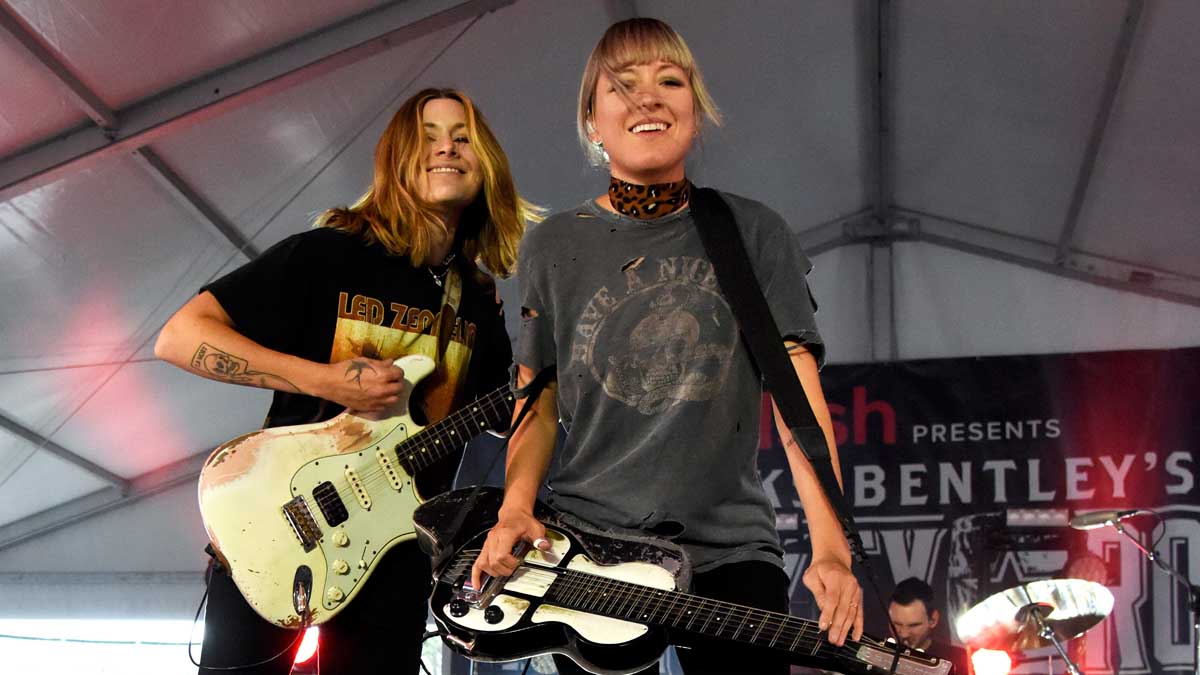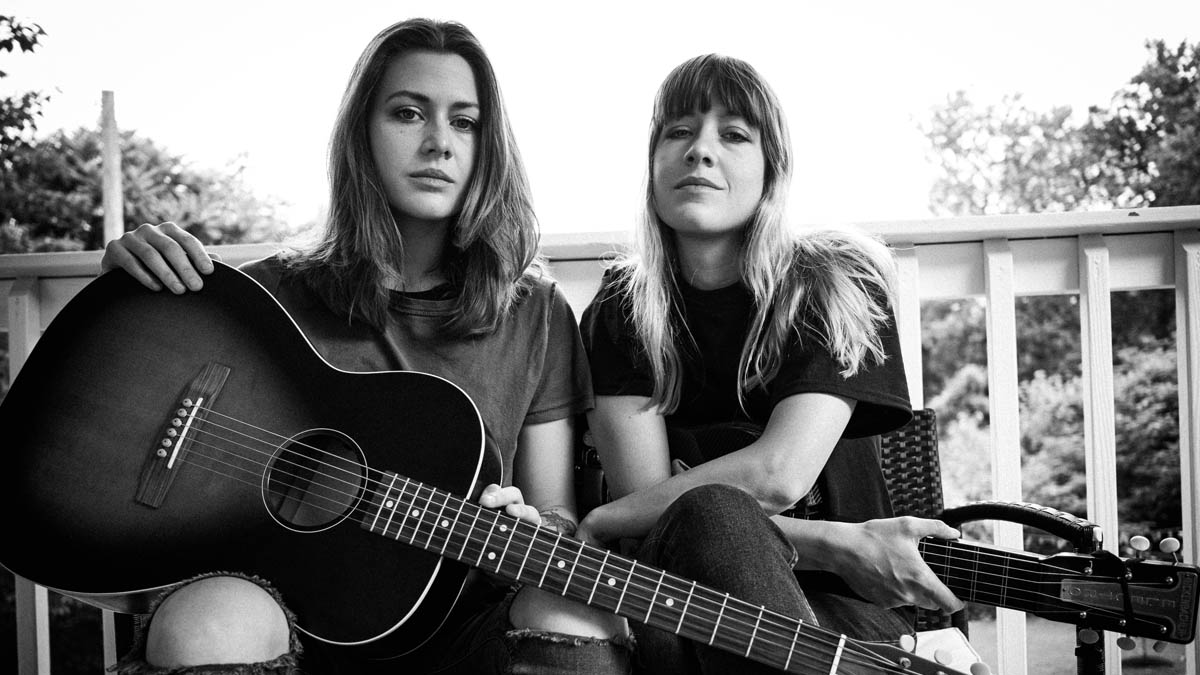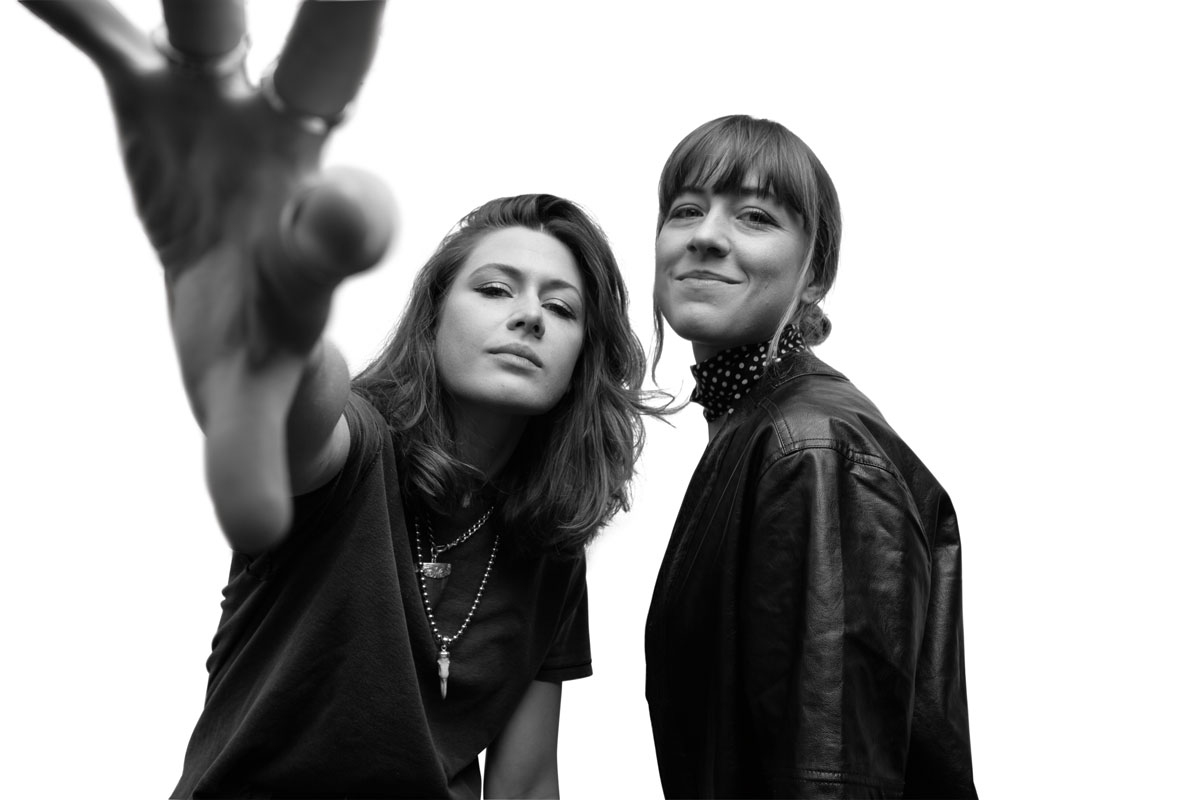Larkin Poe talk gear, tone, telepathy and take a deep dive into their new covers album, Kindred Spirits
Roots-rock sister act Megan and Rebecca Lovell on how they put a signature twist on Elvis, Post Malone and Elton John

Over the last 10 or so years, sibling duo Larkin Poe have become one of the most exciting prospects in guitar music, thanks to their tasteful musicianship and heavenly harmonies.
Latest release Kindred Spirits sees them return to the “covers” format that originally got them noticed, giving us their take on classic hits by Elton John, Neil Young and Elvis Presley, as well as more contemporary cuts by Lenny Kravitz and Post Malone.
“The beauty of the song selection for this was in how organically it all came together,” says Rebecca Lovell, who sings lead and plays guitars, banjos and mandolins in the group while her sister Megan usually sticks with lap steel and harmonies.
“And though it might not seem apparent on the surface, there’s definitely a thread that connects all of these songs. When we first heard the Post Malone song, which features Ozzy Osbourne, I just thought that melody was so cool. And though it’s super modern, Megan and I stripped it back and started playing around with singing it ourselves, trying to nip and tuck the verse parts into more Larkin Poe land.”
“And it really came together,” agrees Megan. “We thought it would be fun to use our approach with a newer song, just to see what would happen. I think it fits in with the classic songs, it kinda has the same feel to it.”
Megan, what can you tell us about your main lap steel guitar?
Megan Lovell: “I first picked up a Rickenbacker. A family friend said they’d seen this really cool vintage one at Gruhn’s Guitars in Nashville, which is an iconic guitar shop, and suggested I go and get it. They felt I would love the tone of the instrument and it wouldn’t steer me wrong.
Get The Pick Newsletter
All the latest guitar news, interviews, lessons, reviews, deals and more, direct to your inbox!
“At the time I was playing Dobro 100 percent of the time, so this was my first foray into electric instruments. I went with their suggestion and bought the Rickenbacker. I feel like I really lucked into it because this is my sound. I fell in love with it and set the Dobro aside because I felt the lap steel could tap into the sounds I was searching for.
Growing up listening to a lot of classic rock and electric stuff, the lap steel married my love of slide and those fat tones I’d been listening to for so long
Megan Lovell
“Growing up listening to a lot of classic rock and electric stuff, the lap steel married my love of slide and those fat tones I’d been listening to for so long. That instrument lasted me a number of years until there was an unfortunate accident in a taxi cab in New York City. The driver slammed on the brakes and the instrument went flying; the neck broke off, unfortunately.
“That was my first love! I knew I needed an identical model to replace it, or one as close as I could find. I ended up looking all over the country and – surprise, an identical model popped up at a Guitar Center in Knoxville, Tennessee. So that’s where my number one ax came from!“
What else do you know about the specs?
Megan: “It’s a B6 model from the early '50s. Nothing has been changed – it’s all original down to the tuners, which are really bent! I’ve wanted to replace them for a while, but one thing about these vintage lap steels is that there aren’t many replacement parts; there’s not much of a demand for it. By default, things have to stay fairly original.“
Rebecca Lovell: “And knowing my sister, I find this quite humorous, she’s very much a tried-and-true individual once she finds something she digs. Her pedalboard has not changed in years.
“She basically buys the same lap steel over and over again, to the point where all of our musical friends immediately send her links when they see a lap steel that’s even remotely similar on Reverb, Craigslist or eBay. And now as a result, Megan has these half-severed versions of this lap steel all over her house. Whenever parts give up, she tries to keep them rock ’n’ rolling.“
What kind of amps and pedals do you both tend to use?
Megan: “I’m a Fender tube amp junkie. I have an old Vibrolux, but most of the time I’m touring with a standard Deluxe Reverb. Pedal-wise, I’m pretty stripped back and don’t really tend to use a lot of stuff.
“I do actually use [Rebecca’s husband] Tyler Bryant’s pedal, the TB Drive by Rodenberg, and it’s a custom one that was made for me. Tyler had “Slide Queen” engraved on it for me. I love that pedal; the tones are great. I was using a Tube Screamer before, and this is almost like having two stacked on top of each other. It’s so versatile.“
Rebecca: “Kindred Spirits was a bit of a twist and a turn for me because I don’t actually play any electric on the record. I actually used this Beard Guitars Sidecar acoustic. He’s an incredible builder in the north, I think around Virginia, predominantly focused on resophonic guitars – a lot of Dobros and square-necks [resonators] to an immaculate standard.
“Over the last couple of years, he’s transitioned into making acoustics. My brother-in-law, Megan’s husband Mike Seal – an incredible guitarist in his own right – was given one of these Beard Deco Phonic Sidecar acoustics, which I became obsessed with. I was borrowing it all the time and realized I shouldn’t be stealing someone else’s.“

So, of course, you had to get your own.
Rebecca: “Yup, I got one for myself and fell in love with it. I actually have two now; I bought one to replace the first one because it was used for Kindred Spirits and we’re auctioning it off to raise proceeds for our one of favorite foundations, Reach Out and Read.
“It’s a very special guitar; I’ve written a lot on it. On the Lenny Kravitz track, I broke out Tyler’s pink resonator, which was built by Mule. He’s another phenom builder, making these really cool resonators.
“I think the actor Jason Momoa is one of his biggest clients and is always promoting Mule. That was about it for me. On more traditional Larkin Poe days, I’m all about the Strat – I have two that are in main rotation. One belonged to Tyler but I’ve taken it now. [Laughs] And recently I’ve started stepping into the Telecaster world.“
Rebecca, you’ve spoken of your electric influences in the past, but since it’s an acoustic record, which players do you think had the most impact on your style?
Rebecca: “I love this question because I’ve never been asked it before! We came up on bluegrass, so in our early teens that’s what we were playing. My main introduction to rhythm acoustic guitar was in that field, and there’s a very distinct style of the right hand with a lot of those players.
“There’s this swagger that no matter how hard I try I can’t quite get out of my right hand. If you listen to any of the players from the Del McCoury Band or someone like Dan Tyminski – there’s this undeniable swagger, that’s definitely the best word to describe it.
“When I accompany myself and Megan with an acoustic, that’s always at the forefront of my mind – providing a lot of the rhythm, covering the backbeat and downbeat with my right hand to keep it propelling and moving forward in time. As for major acoustic influences and the players I’d aspire to channel into my writing, there’s Skip James!
We love the idea of taking a happy song and turning it into minor, that feels very cinematic
Rebecca Lovell
“He is the coolest acoustic guitar player. I find what he does so unusual, especially for a blues musician of that time period. Using all that cross-tuning, he really took it somewhere special. That’s someone I listen to on pretty much a daily basis. If I’m not doing anything else, I’ll have some Skip James going and slowly seeping into my own playing.
We couldn’t help but notice you’d twisted an Elvis hit – (You’re the) Devil in Disguise – from major into minor.
Rebecca: “When we set out to select songs for the album, we obviously had hundreds to pick from, and already so many that we’d covered online. We wanted to branch out and treat people to something new from us.
“We love the idea of taking a happy song and turning it into minor, that feels very cinematic. We were scouring some of our favorite artists, and we hold Elvis in high esteem. Hearing those lyrics we immediately realized it would be so much fun to screw with and create this demonic dance…“
Megan: “Because those lyrics are crying out to be sinister!“
Rebecca: “We sat here in the kitchen and messed around. Megan cross-tuned her lap steel, which she doesn’t do very often. Usually it’s tuned to a major triad chord in G. This time it was minor.“

What else would you say are important things for slide and lap steel players to look out for?
Megan: “First off, pitch is super-important. That’s something you don’t have to think as much about on guitar or any fretted instrument. That’s a major part of it. I started out on violin, so intonation has always been a huge part of playing for me. One thing I actually didn’t enjoy about playing fretted instruments is how it left me missing that part of it.
“I love the fact that you have to be super cognizant of the pitch. Holding the bar, and using banjo picks, feels very awkward at first and very wrong. Just push through that. It won’t last long; if you push through the awkward phase it will start feeling natural pretty quickly.“
Rebecca: “From an outside perspective, having been around Megan’s entire lap steel career, what I think is super important is the character of the vibrato. And that’s something she does innately.
“I recently watched a video where Mike Campbell was talking about the importance of developing the character of your vibrato. It says so much about who you are as a player and the emotional qualities you can express. When Megan plays, it sounds like she’s singing.“
Have you ever tried swapping instruments just to see what would happen?
Rebecca: “I did try to play lap steel and I couldn’t push through it. I didn’t have enough perseverance. But what’s important to note is that if you have the fortitude to get proficient and go through that awkwardness, it pays dividends.
It’s such a unique instrument and it’s so emotional, there’s nothing else like it. I have directly benefited from the fact that Megan has become such a beautiful player, because there’s not many! I think people should stick with it…“
Our folks home-schooled us, so we were kinda free-range children in the bookshelves and we were huge Edgar Allan Poe fans
“I don’t know why it’s not a more common instrument. People need to push through the awkwardness of the mechanics, keeping that bar on the frets, playing in tune with both hands working well together. Once they’ve done that, the main thing will be the vibrato. That’s the absolute arrow and dagger to the heart of steel playing.
Megan: “Side B of that equation is that, because it has such a vocal quality, you really have to be cognizant of the range you’re playing with, especially if there’s a singer. It’s very easy to walk on the vocalist.
“I’ve spent many years working with Rebecca on how to intertwine myself around her voice; especially as two female singers, we have similar ranges. I think sometimes the lap steel gets pegged into a corner as more of a country or Hawaiian thing, but it’s really versatile. I hope it becomes more popular.
As teenagers you found out that your family was connected to Edgar Allan Poe, the tortured genius who wrote The Raven. That’s a pretty cool relative to have.
Rebecca: “This is true! And yeah, we actually didn’t know about it for many years. We had a family genealogist who went back and did the work when we were in our mid-teens. Our folks home-schooled us, so we were kinda free-range children in the bookshelves and we were huge Edgar Allan Poe fans.
“To find that connection was special and carry that sense of family through our music, hoping there’s a trickle-down effect of at least some shred of literary propensity! It’s pretty exciting to be related to someone like that.“

Having grown up together, as well as sharing DNA, do you find it’s quite easy to finish each other’s musical sentences without really talking out loud?
Rebecca: “That is definitely the case. Longstanding musical relationships are built on trust. I’ve seen band members who have been together for years and years… it’s a bit like how owners start to look more like their dogs. Everyone starts to lump together – there’s a shared experience, shared memories and shared musical instincts.
“Looking at footage of Tom Petty and the Heartbreakers, you can see all of those guys can finish each other’s sentences musically. In that sense, that’s been earned by time. We’ve muscled through 15 years of playing together; what makes it special is that many sibling bands aren’t able to weather that through.
We have a special relationship built on so many years of touring together but also the fact that we’re really close in age, less than two years apart, and were always a package deal from the very beginning!
Megan Lovell
“We are gifted with an extra je ne sais quoi in that we are sisters and our voices are similar and we are able to communicate on stage. There’s a very strong siblinghood there that’s undeniable. I find it tragic that, more often than not, a lot of sibling bands end up imploding because they cannot manage the weight being placed on the relationship of brother or sister.
“That’s something we’ve been able to kill, I think, working through issues, writing together, owning a business together and being sisters, sharing family. There’s a lot of trust and that’s the main basis.“
And does that ever feel hard to maintain?
Megan: “Not really – though we’ve worked hard to maintain that trust. We’re together every day working, but we also do fun things together. Just the other day we made apple butter and canned it. We have a special relationship built on so many years of touring together but also the fact that we’re really close in age, less than two years apart, and were always a package deal from the very beginning!“
Rebecca: “I wish everyone could experience it. Hearing about sibling relationships that are fraught make me so sad… because it’s us against the world. If we weren’t making music together, I don’t think either of us would have taken a shot at it professionally.
“It’s a very challenging field and there’s a lot of juggling that’s required, but we have it down between the two of us. We’re definitely a pack. It’s nice to have a pack – hell or high water we will stick together and will keep making records until we can’t walk anymore!“
By the way, Megan – did you ever get around to fixing that original Rickenbacker?
Megan: “I did actually find a lap steel body and put in that original pickup from that first one! The guts of that guitar found a new home and now that’s become my hallowed instrument; I don’t take it out on the road. It stays at the house and stays pristine.
“I also have this lap steel holder that I use to stand up on stage, because I cannot abide sitting down – I have to run around! So I have this retrofitted holder that my guitars slot into, and that’s why they’re all so beaten up. They’re constantly sliding in and out of this holder and they get really scratched up.
“You would see that on any of the lap steels I’ve brought out on the road. The worst point is always the part that rests against my body; there’s always a thick line of scratches on that side, which is weird!“
Rebecca: “It’s really cool, though, because it’s all worn away. Typically the lap steels are black and white, but now that’s worn away and you see this green underneath. It’s really crazy. We call the holder 'the Bedpan,' which is very unflattering, but it definitely looks like one…
“There’s only one of them in the world. We’ve had fans around the world who’ve tried creating replicas for Megan, because if she lost it she’d be up shit creek! It’s falling apart and is duct taped together, so she really needs a new one…
- Larkin Poe's new album, Kindred Spirits, is out now via Tricki Woo.
Amit has been writing for titles like Total Guitar, MusicRadar and Guitar World for over a decade and counts Richie Kotzen, Guthrie Govan and Jeff Beck among his primary influences as a guitar player. He's worked for magazines like Kerrang!, Metal Hammer, Classic Rock, Prog, Record Collector, Planet Rock, Rhythm and Bass Player, as well as newspapers like Metro and The Independent, interviewing everyone from Ozzy Osbourne and Lemmy to Slash and Jimmy Page, and once even traded solos with a member of Slayer on a track released internationally. As a session guitarist, he's played alongside members of Judas Priest and Uriah Heep in London ensemble Metalworks, as well as handled lead guitars for legends like Glen Matlock (Sex Pistols, The Faces) and Stu Hamm (Steve Vai, Joe Satriani, G3).
“The main acoustic is a $100 Fender – the strings were super-old and dusty. We hate new strings!” Meet Great Grandpa, the unpredictable indie rockers making epic anthems with cheap acoustics – and recording guitars like a Queens of the Stone Age drummer
“You can almost hear the music in your head when looking at these photos”: How legendary photographer Jim Marshall captured the essence of the Grateful Dead and documented the rise of the ultimate jam band










